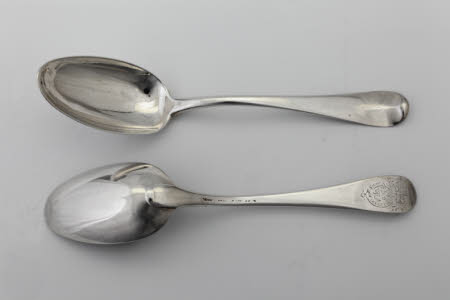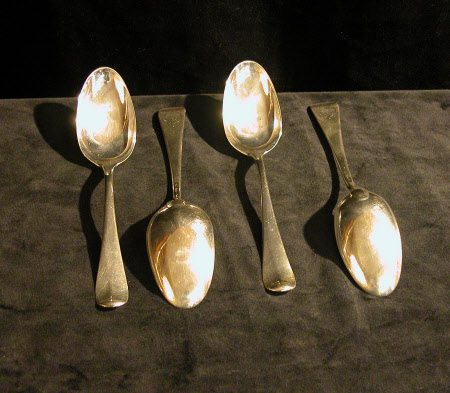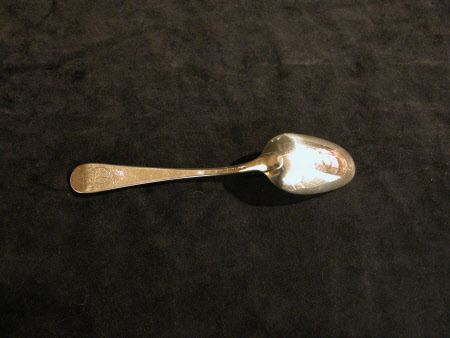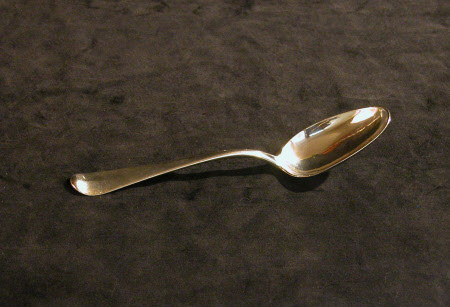Sauce spoon
Paul Callard
Category
Silver
Date
1758 - 1759 (probably)
Materials
Silver
Measurements
4.3 cm (Width); 20.3 cm (Length)
Place of origin
London
Order this imageCollection
Ickworth, Suffolk
NT 852099.31
Summary
Sauce spoon, silver, by Paul Callard, probably 1758/9. One of four. The spoon is forged from a single piece of silver. It is of the Hanoverian single-drop pattern with raised egg-shaped bowl, plain, tapering and curved stem and single drop at the junction with the bowl. The terminal is upturned on the bowl side with a slight rib and is engraved on the opposite side to the bowl with the quartered arms of the Hanoverian monarchs (pre-1801) within the Garter and beneath an imperial crown flanked by the initials GR.
Full description
These four spoons (852099.30-33) have curved stems in order to rest comfortably in the associated sauce boats of 1758/9 by Simon Le Sage (NT 852122) with which they were delivered as part of Lord Bristol’s ambassadorial allocation of plate. Specific flatware for serving sauces seems from an analysis of the Wickes ledgers and Jewel Office records to have emerged in the 1740s, amongst the earliest references being the receipt by Lord Tyrawley and the 4th Earl of Holderness of sauce spoons with their boats on becoming ambassadors in 1744.[1] George Wickes supplied ten spoons with the future 1st Duke of Leinster’s ten sauce boats in 1747 [2] and equal numbers of boats and spoons were the norm, the Dowager Duchess of Somerset receiving four of each in 1749.[3] Ladles were also an option, the Earl of Albemarle receiving four on going to Paris in 1749, and they gradually began to supplant spoons.[4] Whereas in 1758 and in 1760 both Lord Bristol and the 9th Earl of Kinnoull, the latter as ambassador to Portugal, chose sauce spoons, in 1762 the 2nd Earl of Egremont as Secretary of State, Sir John Cust as Speaker and the 2nd Earl of Buckinghamshire as ambassador to Russia all had ladles rather than spoons with their sauce boats.[5] Because such spoons can easily become detached from their boats, and even be straightened, it is rare to find a recorded pairing such as that at Ickworth surviving intact. There must, presumably, have been sauce spoons for Lord Bristol’s other eight sauce boats but they have not survived. James Rothwell, Decorative Arts Curator January 2021 [Adapted from James Rothwell, Silver for Entertaining: The Ickworth Collection, London 2017, cat. 66, p. 150.] Notes: [1] The National Archives, LC 9/45, Jewel Office Delivery Book 1732–93, f. 92. In 1719 Lord Cartaret had received ‘Eight Sauce Spoones’ on going to Sweden as ambassador but their combined weight of 59oz 7dwt suggests they were ragout spoons rather than for use with sauce boats: LC 9/44, Jewel Office Delivery Book 1698–1732, f. 232. There are ladles of c.1740 by Paul de Lamerie associated with a pair of earlier sauce boats in the Gilbert Collection, see Timothy Schroder, The Gilbert Collection of Gold and Silver, 1988, cat. 53, pp. 214-7. [2] National Art Library, Garrard Ledgers, VAM 3 1747–50, f. 1. [3] Ibid., f. 86. [4] Jewel Office Delivery Book 1732–93 (see note 1), f. 108. [5] Ibid, ff. 165, 181 and 196.
Provenance
Jewel Office; allocated to George Hervey, 2nd Earl of Bristol (1721-75) as Ambassador to Madrid 1758; discharged to Lord Bristol 9th April, 1759; by descent to the 4th Marquess of Bristol (1863-1951); accepted by the Treasury in lieu of death duties in 1956 and transferred to the National Trust.
Credit line
Ickworth, the Bristol Collection (National Trust)
Marks and inscriptions
Stem: Hallmarks: stamped four times on the reverse of the stem with the maker’s mark ‘PC’ beneath two mullets and above a fleur-de-lis (Arthur Grimwade, London Goldsmiths 1697-1837, 1990, no. 2150).
Makers and roles
Paul Callard, goldsmith



